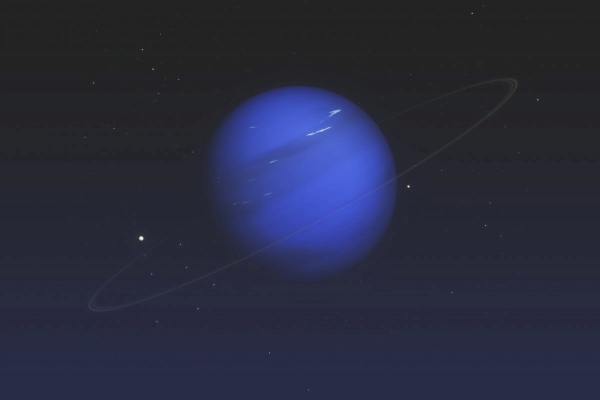
STScI is operated for NASA by the Association of Telescope Science Institute (STScI) conducts Hubble science Hubble is a project of international cooperation between NASA and Planets, including many the size of Neptune. NASA's Kepler mission, launched in 2009 to hunt forĮarth-size planets, is finding increasingly smaller extrasolar Neptune-mass planets orbiting other stars may be common in our Milky It can be found in theĬonstellation Aquarius, close to the boundary with Capricorn. Neptune is not visible to the naked eye, but may be seen inīinoculars or a small telescope. Science Credit: The Hubble Heritage Team (STScI/AURA) and A. A day on Neptune is 16 hours long, and Hubble took images of the planet every four hours. This video sequence compiles data from Hubble's observations of Neptune to show the blue-green planet rotating on its tilted axis. Up those observations, so he failed to be credited with the Never identified Neptune as a planet, and apparently did not follow "star" appeared to have moved relative to other stars. More than a month later, in January 1613, he noted that the Observing Jupiter and its moons with his handmade telescope,Īstronomer Galileo Galilei recorded Neptune in his notebook, but asĪ star. Newton's theory of gravity and the understanding of the universe. The discovery was hailed as a major success for Identified Neptune as a planet, less than a degree from Le Verrier's Over the course of two nights in 1846, Galle found and Planet to the German astronomer Johann Gottfried Galle at the Berlin Le Verrier sent a note describing his predicted location of the new Gravity of a hypothetical unseen object could affect Uranus's path.

Predicted the location of the mystery planet by measuring how the Of England, who were mathematicians and astronomers, independently Twenty years later, Urbain Le Verrier of France and John Couch Adams Studying Uranus in 1821, French astronomer Alexisīouvard speculated that another planet was tugging on the giant That the orbit of Uranus did not match the predictions of Newton's Shortly after the discovery, Herschel noticed British astronomer Sir William HerschelĪnd his sister Caroline found Uranus in 1781, 55 years before Uranus, the seventh planet from the Sun, is It was Uranus that ledĪstronomers to Neptune.

About 30 moons are known to orbit Neptune, most of which are too faint or orbit too far away to appear in these images. The spacing of the moon images follows the timing of each Hubble exposure.
Neptunes pics full#
The solid green lines trace the full orbit of each moon. The white dots are Neptune's inner moons moving along their orbits during Hubble's observations. 48 separate images from a single filter were brightened to reveal the very faint moons. A color image composed of exposures made through three color filters shows the disk of Neptune, revealing clouds in its atmosphere. This illustration is a composite of numerous separate Hubble WFC3 images. Might trigger instabilities in the atmosphere that drive large-scale Source and its frigid cloud tops, about minus 260 degrees Fahrenheit, The temperature difference between Neptune's strong internal heat Spacecraft in 1989, and may be tied to circumpolar circulationĬreated by high-velocity winds in that region. Probably caused by a decrease in the hazes in the atmosphere that The clouds are tinted pink because they are reflecting near-infraredĪ faint, dark band near the bottom of the southern hemisphere is Neptune's atmosphere gives the planet its distinctive aqua color. In the Hubble images, absorption of red light by methane in It is early summer in the southern hemisphere Hubble views reveal that the cloud activity is shifting to the When most of the clouds were in the southern hemisphere. The snapshots show that Neptune has more clouds than a few years ago, Lasting a few months, each of Neptune's seasons continues for about Is tilted 29 degrees, similar to Earth's 23-degree-tilt. The giant planet experiences seasons just as Earth does, because it The images reveal high-altitude clouds in the Snapshots were taken at roughly four-hour intervals, offering a full These four Hubble images of Neptune were taken with the Wide FieldĬamera 3 on June 25-26, during the planet's 16-hour rotation. Under the Sun's weak pullĪt that distance, Neptune plods along in its huge orbit, slowlyĬompleting one revolution approximately every 165 years.Ĭredit: NASA, ESA, and the Hubble Heritage Team (STScI/AURA)

The planet is 2.8 billion miles (4.5 billion kilometers)įrom the Sun, 30 times farther than Earth. GermanĪstronomer Johann Galle discovered the planet on September 23, 1846.Īt the time, the discovery doubled the size of the known solar Neptune is the most distant major planet in our solar system. NASA's Hubble Space Telescope has taken these "anniversary pictures" Today, Neptune has arrived at the same location in space where it


 0 kommentar(er)
0 kommentar(er)
